Publication 505 - Tax Withholding And Estimated Tax Page 22
ADVERTISEMENT
Required Annual Payment
tract your expected withholding from your re-
Fiscal year taxpayers. If your tax year does
quired annual payment. You usually must pay
not start on January 1, your payment due dates
this difference in four equal installments. (See
are:
You figure the total amount you must pay for
When To Pay Estimated Tax and How To Figure
2002 through withholding and estimated tax
1) The 15th day of the 4th month of your
Each Payment, later.)
payments on lines 14a through 14c of the 2002
fiscal year,
Estimated Tax Worksheet.
If your total expected tax on line 13c, minus
your expected withholding on line 15, is less
2) The 15th day of the 6th month of your
General rule. The total amount you must pay
than $1,000, you do not need to make estimated
fiscal year,
is the smaller of:
tax payments.
3) The 15th day of the 9th month of your
1) 90% of your total expected tax for 2002, or
fiscal year, and
Withholding. Your expected withholding for
2) 100% of the total tax shown on your 2001
2002 includes the income tax you expect to be
4) The 15th day of the 1st month after the
return. Your 2001 tax return must cover all
withheld from all sources (wages, pensions and
end of your fiscal year.
12 months.
annuities, etc.). It also includes excess social
You do not have to make the last payment
security and railroad retirement tax you expect
listed above if you file your income tax return by
Exceptions. There are exceptions to the gen-
to be withheld from your wages.
the last day of the first month after the end of
eral rule for certain higher income taxpayers and
For this purpose, you will have excess social
your fiscal year and pay all the tax you owe with
for farmers and fishermen.
security or tier 1 railroad retirement tax withhold-
your return.
ing for 2002 only if your wages from two or more
Higher income taxpayers. If your adjusted
employers are more than $84,900.
gross income (AGI) for 2001 was more than
When To Start
$150,000 ($75,000 if your filing status for 2002 is
married filing a separate return), substitute
You do not have to make estimated tax pay-
112% for 100% in (2) above. This rule does not
ments until you have income on which you will
When To Pay
apply to farmers and fishermen.
owe the tax. If you have income subject to esti-
For 2001, AGI is the amount shown on Form
Estimated Tax
mated tax during the first payment period, you
1040 – line 34; Form 1040A – line 20; and Form
must make your first payment by the due date
1040EZ – line 4.
for the first payment period. You can pay all your
For estimated tax purposes, the year is divided
estimated tax at that time, or you can pay it in
Farmers and fishermen. If at least
into four payment periods. Each period has a
installments. If you choose to pay in install-
two-thirds of your gross income for 2001 or 2002
specific payment due date. If you do not pay
ments, make your first payment by the due date
is from farming or fishing, your required annual
enough tax by the due date of each of the pay-
for the first payment period. Make your remain-
payment is the smaller of:
ment periods, you may be charged a penalty
ing installment payments by the due dates for
even if you are due a refund when you file your
1) 66
2
/
% (.6667) of your total tax for 2002, or
the later periods.
3
income tax return. The following chart gives the
2) 100% of the total tax shown on your 2001
payment periods and due dates for estimated
No income subject to estimated tax during
return. (Your 2001 tax return must cover
tax payments.
first period. If you first have income subject to
all 12 months.)
estimated tax during a later payment period, you
Table 2.3
For definitions of “gross income from farm-
must make your first payment by the due date
ing” and “gross income from fishing,” see Farm-
for that period. You can pay your entire esti-
For the period:
Due date:
ers and Fishermen later under When To Pay
mated tax by the due date for that period or you
Jan. 1* through March 31 . . . .
April 15
Estimated Tax.
can pay it in installments by the due date for that
April 1 through May 31 . . . . .
June 15
period and the due dates for the remaining peri-
June 1 through August 31 . . .
September 15
Total tax for 2001. Your 2001 total tax on
Sept. 1 through Dec. 31 . . . . .
Jan. 15 next
ods. The following chart shows the dates for
Form 1040 is the amount on line 58 reduced by
year**
making installment payments.
the total of the amounts on lines 54, 61a, and 63,
*If your tax year does not begin on January 1, see
any credit from Form 4136 included on line 65,
Table 2.4
Fiscal year taxpayers, later.
any recapture of a federal mortgage subsidy and
**See January payment, later.
If you first have
any uncollected social security, Medicare, or
income on which
railroad retirement tax included on line 58, and
you must pay
Make a
Make later in-
Saturday, Sunday, holiday rule. If the due
any tax on excess contributions to IRAs and
estimated tax:
payment by:
stallments by:
date for making an estimated tax payment falls
medical savings accounts, and on excess accu-
Before April 1
April 15
June 15
on a Saturday, Sunday, or legal holiday, the
mulations in qualified retirement plans from
September 15
payment will be on time if you make it on the next
Form 5329 included on line 55.
January 15
day that is not a Saturday, Sunday, or legal
On Form 1040A, it is line 36 reduced by the
next year*
holiday. For example, a payment due Saturday,
amounts on lines 39a and 40. On Form 1040EZ,
After March 31
June 15, 2002, will be on time if you make it by
it is line 11 reduced by line 9a.
and before
Monday, June 17, 2002.
June 1
June 15
September 15
Example 2.5. Jeremy Martin’s total tax on
January 15
his 2001 return was $45,000, and his expected
next year*
January payment. If you file your 2002 Form
After May 31 and
tax for 2002 is $70,000. His 2001 AGI was
1040 or Form 1040A by January 31, 2003, and
before
$180,000. Because Jeremy had more than
pay the rest of the tax you owe, you do not need
Sept. 1
September 15
January 15
$150,000 of AGI in 2001, he figures his required
to make your estimated tax payment that would
next year*
annual payment as follows. He determines that
be due on January 15, 2003.
After August 31
January 15
90% of his expected tax for 2002 is $63,000 (.90
next year*
(None)
× $70,000). Next, he determines that 112% of
Example 2.6. Janet Adams does not pay
*See January payment and Saturday, Sunday,
the tax shown on his 2001 return is $50,400.
any estimated tax due for 2002. She files her
holiday rule under When To Pay Estimated Tax,
Finally, he determines that his required annual
earlier.
2002 income tax return and pays the balance
payment is $50,400, the smaller of the two.
due as shown on her return on January 24,
2003.
Change in estimated tax. After making your
Total Estimated
Janet’s estimated tax for the fourth payment
first estimated tax payment, changes in your
Tax Payments
period is considered to have been paid on time.
income, adjustments, deductions, credits, or ex-
However, she may owe a penalty for not making
emptions may make it necessary for you to
Figure the total amount you must pay for 2002
the first three estimated tax payments. Any pen-
refigure your estimated tax. Pay the unpaid bal-
through estimated tax payments on lines 15 and
alty for not making those payments will be fig-
ance of your amended estimated tax by the next
16 of the 2002 Estimated Tax Worksheet. Sub-
ured up to January 24, 2003.
payment due date after the change or in install-
Page 22
Chapter 2 Estimated Tax for 2002
ADVERTISEMENT
0 votes
Related Articles
Related forms
Related Categories
Parent category: Financial
 1
1 2
2 3
3 4
4 5
5 6
6 7
7 8
8 9
9 10
10 11
11 12
12 13
13 14
14 15
15 16
16 17
17 18
18 19
19 20
20 21
21 22
22 23
23 24
24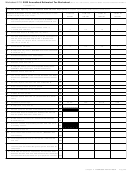 25
25 26
26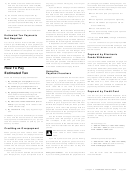 27
27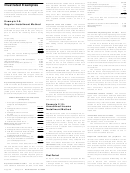 28
28 29
29 30
30 31
31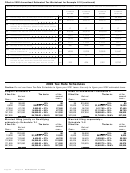 32
32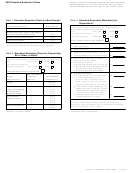 33
33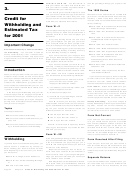 34
34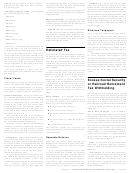 35
35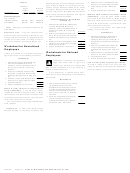 36
36 37
37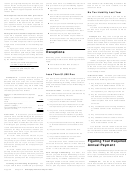 38
38 39
39 40
40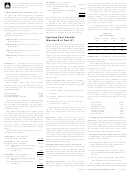 41
41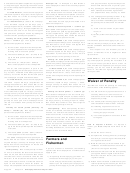 42
42 43
43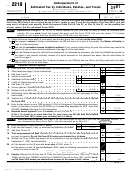 44
44 45
45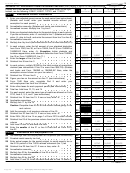 46
46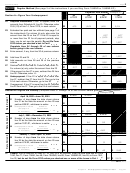 47
47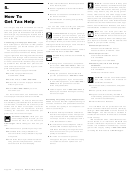 48
48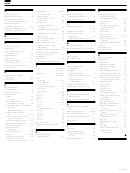 49
49








